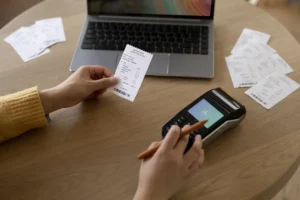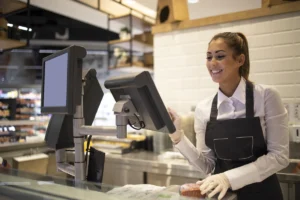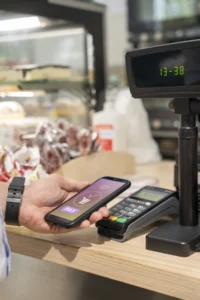A POS, which stands for Point Of Sale or point of purchase, is a special computer program used by businesses to help them keep track of sales and manage money.

List of Queue Management Software for SMBs

A POS, which stands for Point Of Sale or point of purchase, is a special computer program used by businesses to help them keep track of sales and manage money.
This smart system helps store owners and workers easily handle when customers buy things and pay for them.
It also keeps a detailed record of all the things that were sold. It’s known for being easy to set up and easy to use.
The main job of a POS is to handle transactions when customers buy things, whether they’re shopping online or in a physical store.
This kind of software is used all around the world to help with money management. It’s so versatile that it’s even used in restaurants, salons, supermarkets, and places where you can make payments.
It’s like a superhero of software for keeping track of money and sales. There are various components of a POS system that work together to ensure smooth and accurate transactions in a retail environment.
Today through this blog, we are going to explain various components of the POS system
Content Index

A POS system consists of two key components: hardware and software.
The hardware encompasses the physical equipment, such as the register and touch screen.
Transactions take place here, where orders are entered and payments are handled.
Additionally, staff members can manage orders and payments at clients’ tables using mobile devices like tablets.
Kiosks, which resemble large displays and allow customers to place orders on their own, are available in select locations.
The computer program that operates on the hardware is known as the software.
It serves as the system’s “brains,” tracking orders, making sure the proper goods are delivered to the right customers, and computing overall costs.
Additionally, the software contains product information and aids managers in performance analysis.
POS hardware constitutes the tangible tools employed to handle customer payments within a brick-and-mortar establishment.
This encompasses an array of devices, such as credit card readers, scales, screens, workstations, receipt printers, and beyond.
Collectively, these elements converge to form input and output mechanisms, facilitating the seamless execution of transactions.
Barcode scanner, Receipt printer, Cash drawer, Card Reader with a Signature pad, Associate Display, and Monitor are the main hardware components of a POS system. Let us discuss each of them in detail:

The inclusion of a barcode scanner in your POS system enables the seamless integration of product details into the software, automating the computation of the customer’s payment total.
In the absence of a barcode scanner, the manual entry of each item into the software prior to payment processing becomes necessary.
These scanners find extensive application in businesses that manage substantial inventories, like supermarkets or hardware outlets.

The role of a receipt printer is to furnish customers with a tangible record of their transaction particulars.
While commonly found in retail establishments, a growing number of businesses are opting for cost-effective measures by providing digital receipts.
Nevertheless, physical receipts retain their popularity among customers, particularly those who may anticipate the need for future item returns.

A cash drawer serves its purpose quite literally: it’s a tangible compartment designed to hold your cash funds.
Generally, the POS software is equipped with a mechanism to open this drawer when customers opt to pay with cash or require change during their transaction.
Establishments that experience minimal cash transactions, like apparel boutiques, have the flexibility to forgo the inclusion of a cash drawer if they so choose.

Considered a fundamental POS hardware component, the credit card reader often springs to mind as one of the initial elements associated with POS systems.
These devices for capturing signatures employ integrated payment methods to decipher credit cards, debit cards, gift cards, and other payment alternatives.
They can also interface with cash drawers for expanded payment functionality. These card readers adhere to EMV standards, incorporating both chip and magnetic stripe reading capabilities.
The signature capture devices harmonize the payment procedure, ensuring a rapid, effective, and precise transaction process.

Although retail establishments use this function more frequently, the customer store display shows customers their subtotal and complete prices.
Most POS systems do not require it. Nevertheless, a lit display informs buyers of the final cost of their purchases. On this display, you can customize the messages or promote your items.

The monitor is a crucial part of the POS system that shows information about sales while a transaction is happening.
The people working with the system can use the monitor to put in what was bought, see the prices, taxes, any discounts, how much everything costs, and other important details. This information is different depending on the type of business.
For example, in a restaurant, the monitor would show the food that was ordered, while in a hotel, it would show the rooms and things people rented.
The monitor works together with other things like a computer in the office, a keyboard, a mouse, a cash drawer, and a receipt printer.
POS software serves as the backbone for efficiently handling brick-and-mortar businesses and conducting face-to-face sales.
This specialized system empowers store personnel to locate items, include them in a customer’s purchase, and process payments seamlessly.
Furthermore, POS software encompasses valuable utilities such as generating sales reports, overseeing inventory, and seamlessly integrating customer loyalty initiatives.
Having the right hardware is just the beginning; you also require compatible software as the components of the POS system to make everything function smoothly.
POS software is a vital component of any business setup, offering comprehensive solutions that enhance efficiency and overall performance, regardless of the industry.
Cloud-based POS software works like when you save a digital file in your iCloud or Google Drive.
You can get your files from any gadget if you’re signed in to the account connected to the cloud’s server.
But, a regular POS system is more like saving a digital file on one device, just like a Word document on your computer.
You can only open your Word document on your computer unless you make a copy and put it on another device.
Cloud-based POS offers various benefits like accuracy, insights, consistency, and ease of managing promotions.
An on-premise POS, also known as a traditional or legacy POS, involves storing all information within a local database situated on your computer’s hard drive.
As a result, access to this data is only possible when you’re using your computer and have the drive open.
An mPOS (mobile point-of-sale) is a wireless device, such as a smartphone, tablet, or dedicated gadget, designed to execute the tasks of a cash register or electronic point-of-sale terminal (POS terminal) through wireless means.
mPOS proves valuable for enterprises needing to conduct transactions while on the move. Businesses selling digital products can leverage payment solutions for digital product sales to securely process transactions and manage payments efficiently.
Retail operations are streamlined by hybrid POS (Point of Sale) software, which seamlessly blends the advantages of local and cloud-based systems.
It combines information about sales, inventories, and customers and provides real-time insights and flexible features for increased productivity.
This ground-breaking approach optimizes both in-store and online shopping, guaranteeing seamless transactions and unique customer experiences.
The iPad POS software for restaurants will manage multiple venues, loyalty initiatives, insightful reports, and meticulous inventory control.
Seamlessly syncing with Mac systems, it centralizes data management. Moreover, the software enables online order integration, preserving earnings, and allowing for innovative profit analysis and presentation.
It’s important to choose the right POS software for your company. Find a system that fits your unique requirements, such as managing sales, inventory, and customers.
It should provide simple customization options, dependable support, and user-friendly interfaces.
In general, using cloud-based POS software gives businesses more flexibility than hosting on a local server.
Additionally, a cloud-based solution may rapidly match your demand for additional bandwidth rather than requiring a complicated update to your IT infrastructure.
Ultimately, the ideal POS software equips your company with effective operations, enhanced customer experiences, and customizable features that boost development and success.
The POS system is a valuable tool for managing your business. As you use it regularly, you’ll become comfortable with the software’s interface.
But if you’re just beginning, this detailed guide is here to assist. It explains the vital components of the POS system, including the necessary hardware and fundamental software features, making it easier to understand.
Great! What’s the single biggest challenge you’d like a software solution to solve for your business? 🎯
💡 Suggested Solution Ideas:
Just one more step! Share your details so our experts can connect with you personally and discuss tailored solutions. 🤝
Thank You for Connecting! 🎉
We've received your information and a specialist will be in touch with you very shortly to discuss how we can help your business thrive.
In the meantime, feel free to browse our resources or reach out if you have immediate questions.
Understood! 🙏
No worries if you're not exploring software solutions right now. Our door is always open if your needs change!
Feel free to explore our other offerings or connect with us anytime.